The Impact of Historical Events on the Relationship between Indigenous People of Australia and the Wider Australian Society
VerifiedAdded on 2023/04/23
|16
|4051
|305
AI Summary
This essay analyses the historical events and policies that have influenced the changing attitude of European settlers towards Aboriginal people in Australia. The referendum of 1967 sought to offer equal citizenship rights to Indigenous people, while the initiative of the Australian government to return back the land of Uluru to Indigenous people in 1985 aimed to redeem the great injustice that had been committed against them.
Contribute Materials
Your contribution can guide someone’s learning journey. Share your
documents today.

Name: Kelly Camm
Student no: 94041211
Unit: IKC101 Indigenous Australian Cultures, Histories and Contemporary
Realities
Course: 1416SW - Bachelor of Social Science (Social Welfare)
Coordinator: Kirsten Locke
Assessment Three
Submission Date: 13 May 2019
Word Entry: 1,442
Student no: 94041211
Unit: IKC101 Indigenous Australian Cultures, Histories and Contemporary
Realities
Course: 1416SW - Bachelor of Social Science (Social Welfare)
Coordinator: Kirsten Locke
Assessment Three
Submission Date: 13 May 2019
Word Entry: 1,442
Secure Best Marks with AI Grader
Need help grading? Try our AI Grader for instant feedback on your assignments.
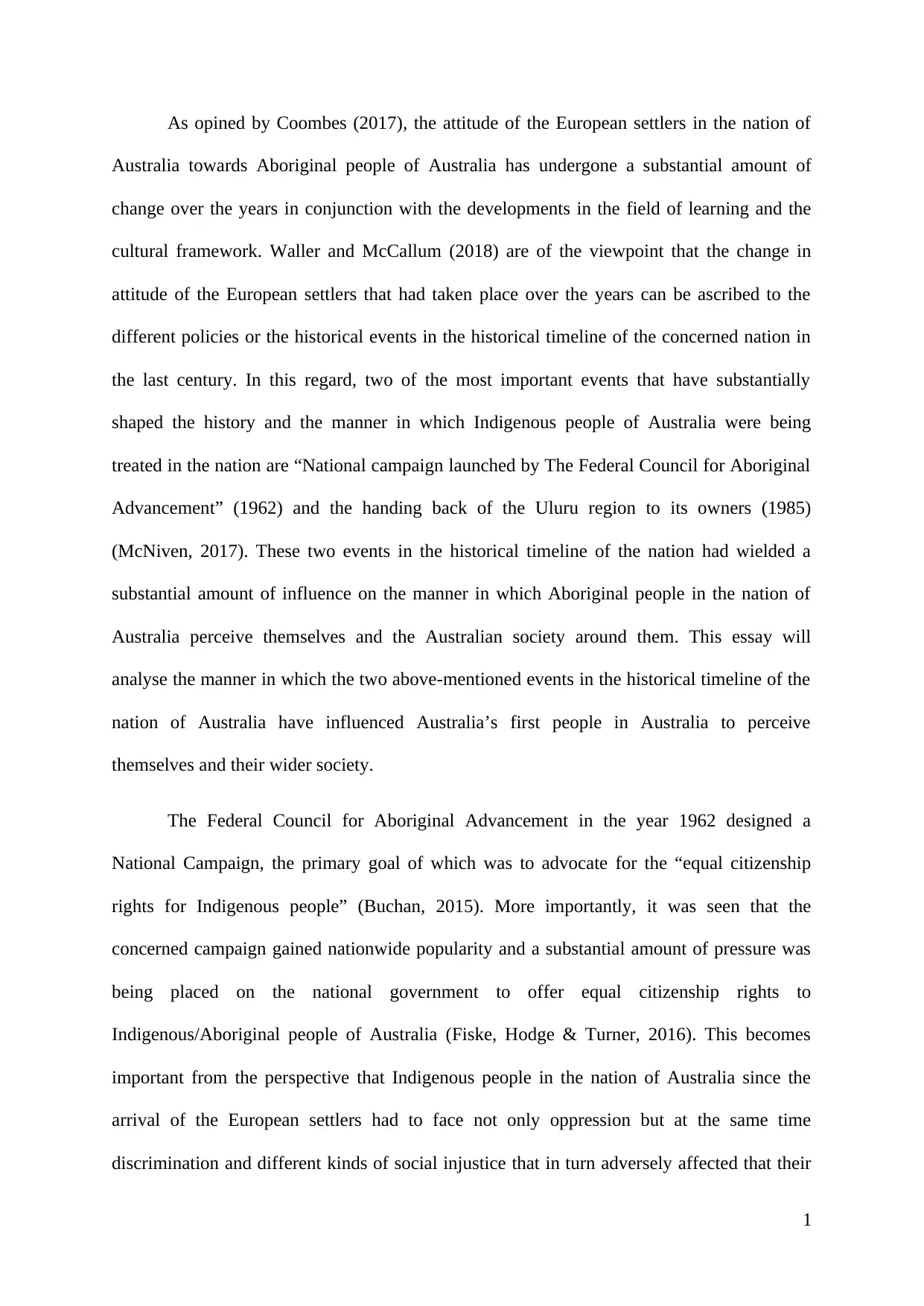
As opined by Coombes (2017), the attitude of the European settlers in the nation of
Australia towards Aboriginal people of Australia has undergone a substantial amount of
change over the years in conjunction with the developments in the field of learning and the
cultural framework. Waller and McCallum (2018) are of the viewpoint that the change in
attitude of the European settlers that had taken place over the years can be ascribed to the
different policies or the historical events in the historical timeline of the concerned nation in
the last century. In this regard, two of the most important events that have substantially
shaped the history and the manner in which Indigenous people of Australia were being
treated in the nation are “National campaign launched by The Federal Council for Aboriginal
Advancement” (1962) and the handing back of the Uluru region to its owners (1985)
(McNiven, 2017). These two events in the historical timeline of the nation had wielded a
substantial amount of influence on the manner in which Aboriginal people in the nation of
Australia perceive themselves and the Australian society around them. This essay will
analyse the manner in which the two above-mentioned events in the historical timeline of the
nation of Australia have influenced Australia’s first people in Australia to perceive
themselves and their wider society.
The Federal Council for Aboriginal Advancement in the year 1962 designed a
National Campaign, the primary goal of which was to advocate for the “equal citizenship
rights for Indigenous people” (Buchan, 2015). More importantly, it was seen that the
concerned campaign gained nationwide popularity and a substantial amount of pressure was
being placed on the national government to offer equal citizenship rights to
Indigenous/Aboriginal people of Australia (Fiske, Hodge & Turner, 2016). This becomes
important from the perspective that Indigenous people in the nation of Australia since the
arrival of the European settlers had to face not only oppression but at the same time
discrimination and different kinds of social injustice that in turn adversely affected that their
1
Australia towards Aboriginal people of Australia has undergone a substantial amount of
change over the years in conjunction with the developments in the field of learning and the
cultural framework. Waller and McCallum (2018) are of the viewpoint that the change in
attitude of the European settlers that had taken place over the years can be ascribed to the
different policies or the historical events in the historical timeline of the concerned nation in
the last century. In this regard, two of the most important events that have substantially
shaped the history and the manner in which Indigenous people of Australia were being
treated in the nation are “National campaign launched by The Federal Council for Aboriginal
Advancement” (1962) and the handing back of the Uluru region to its owners (1985)
(McNiven, 2017). These two events in the historical timeline of the nation had wielded a
substantial amount of influence on the manner in which Aboriginal people in the nation of
Australia perceive themselves and the Australian society around them. This essay will
analyse the manner in which the two above-mentioned events in the historical timeline of the
nation of Australia have influenced Australia’s first people in Australia to perceive
themselves and their wider society.
The Federal Council for Aboriginal Advancement in the year 1962 designed a
National Campaign, the primary goal of which was to advocate for the “equal citizenship
rights for Indigenous people” (Buchan, 2015). More importantly, it was seen that the
concerned campaign gained nationwide popularity and a substantial amount of pressure was
being placed on the national government to offer equal citizenship rights to
Indigenous/Aboriginal people of Australia (Fiske, Hodge & Turner, 2016). This becomes
important from the perspective that Indigenous people in the nation of Australia since the
arrival of the European settlers had to face not only oppression but at the same time
discrimination and different kinds of social injustice that in turn adversely affected that their
1
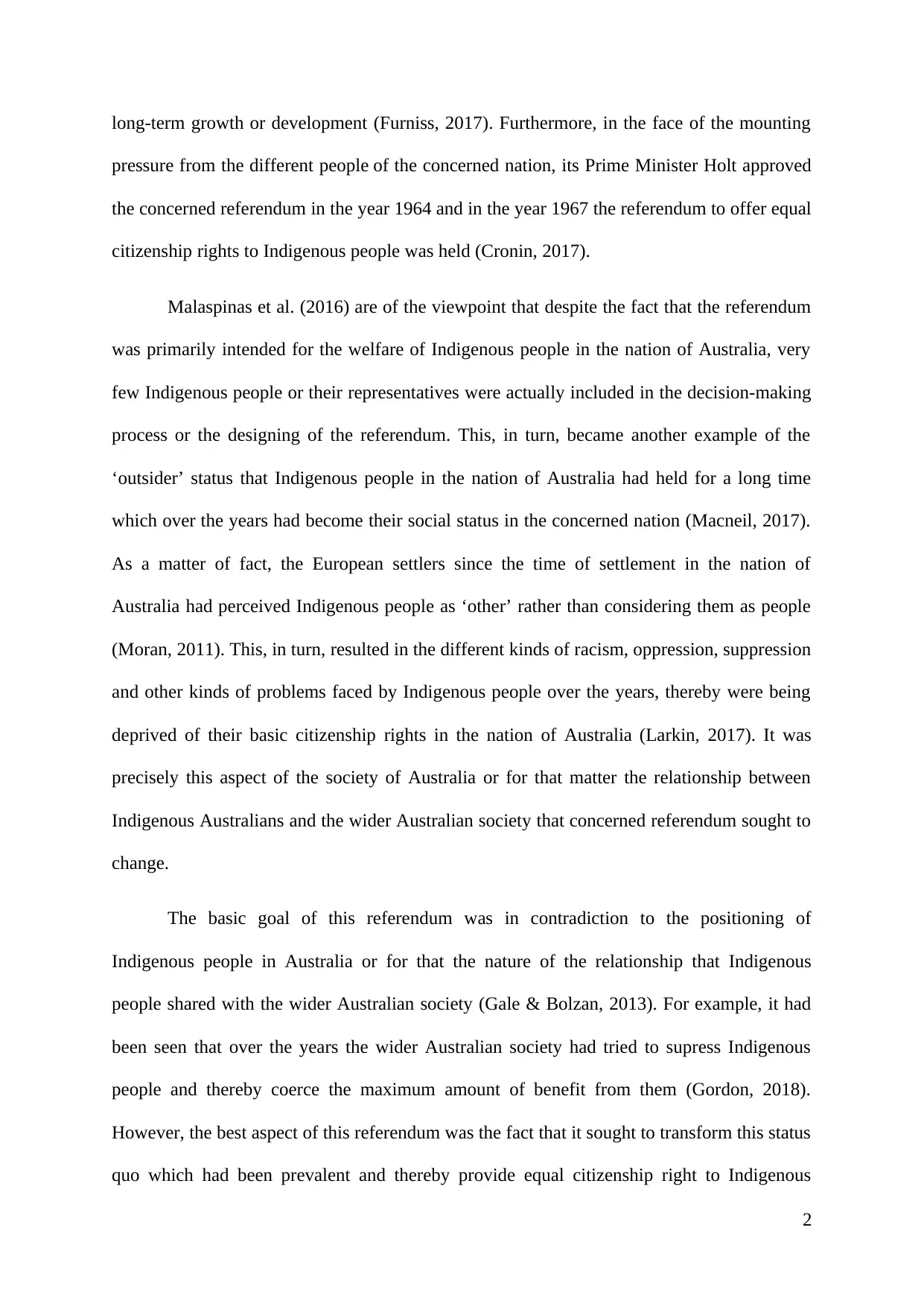
long-term growth or development (Furniss, 2017). Furthermore, in the face of the mounting
pressure from the different people of the concerned nation, its Prime Minister Holt approved
the concerned referendum in the year 1964 and in the year 1967 the referendum to offer equal
citizenship rights to Indigenous people was held (Cronin, 2017).
Malaspinas et al. (2016) are of the viewpoint that despite the fact that the referendum
was primarily intended for the welfare of Indigenous people in the nation of Australia, very
few Indigenous people or their representatives were actually included in the decision-making
process or the designing of the referendum. This, in turn, became another example of the
‘outsider’ status that Indigenous people in the nation of Australia had held for a long time
which over the years had become their social status in the concerned nation (Macneil, 2017).
As a matter of fact, the European settlers since the time of settlement in the nation of
Australia had perceived Indigenous people as ‘other’ rather than considering them as people
(Moran, 2011). This, in turn, resulted in the different kinds of racism, oppression, suppression
and other kinds of problems faced by Indigenous people over the years, thereby were being
deprived of their basic citizenship rights in the nation of Australia (Larkin, 2017). It was
precisely this aspect of the society of Australia or for that matter the relationship between
Indigenous Australians and the wider Australian society that concerned referendum sought to
change.
The basic goal of this referendum was in contradiction to the positioning of
Indigenous people in Australia or for that the nature of the relationship that Indigenous
people shared with the wider Australian society (Gale & Bolzan, 2013). For example, it had
been seen that over the years the wider Australian society had tried to supress Indigenous
people and thereby coerce the maximum amount of benefit from them (Gordon, 2018).
However, the best aspect of this referendum was the fact that it sought to transform this status
quo which had been prevalent and thereby provide equal citizenship right to Indigenous
2
pressure from the different people of the concerned nation, its Prime Minister Holt approved
the concerned referendum in the year 1964 and in the year 1967 the referendum to offer equal
citizenship rights to Indigenous people was held (Cronin, 2017).
Malaspinas et al. (2016) are of the viewpoint that despite the fact that the referendum
was primarily intended for the welfare of Indigenous people in the nation of Australia, very
few Indigenous people or their representatives were actually included in the decision-making
process or the designing of the referendum. This, in turn, became another example of the
‘outsider’ status that Indigenous people in the nation of Australia had held for a long time
which over the years had become their social status in the concerned nation (Macneil, 2017).
As a matter of fact, the European settlers since the time of settlement in the nation of
Australia had perceived Indigenous people as ‘other’ rather than considering them as people
(Moran, 2011). This, in turn, resulted in the different kinds of racism, oppression, suppression
and other kinds of problems faced by Indigenous people over the years, thereby were being
deprived of their basic citizenship rights in the nation of Australia (Larkin, 2017). It was
precisely this aspect of the society of Australia or for that matter the relationship between
Indigenous Australians and the wider Australian society that concerned referendum sought to
change.
The basic goal of this referendum was in contradiction to the positioning of
Indigenous people in Australia or for that the nature of the relationship that Indigenous
people shared with the wider Australian society (Gale & Bolzan, 2013). For example, it had
been seen that over the years the wider Australian society had tried to supress Indigenous
people and thereby coerce the maximum amount of benefit from them (Gordon, 2018).
However, the best aspect of this referendum was the fact that it sought to transform this status
quo which had been prevalent and thereby provide equal citizenship right to Indigenous
2
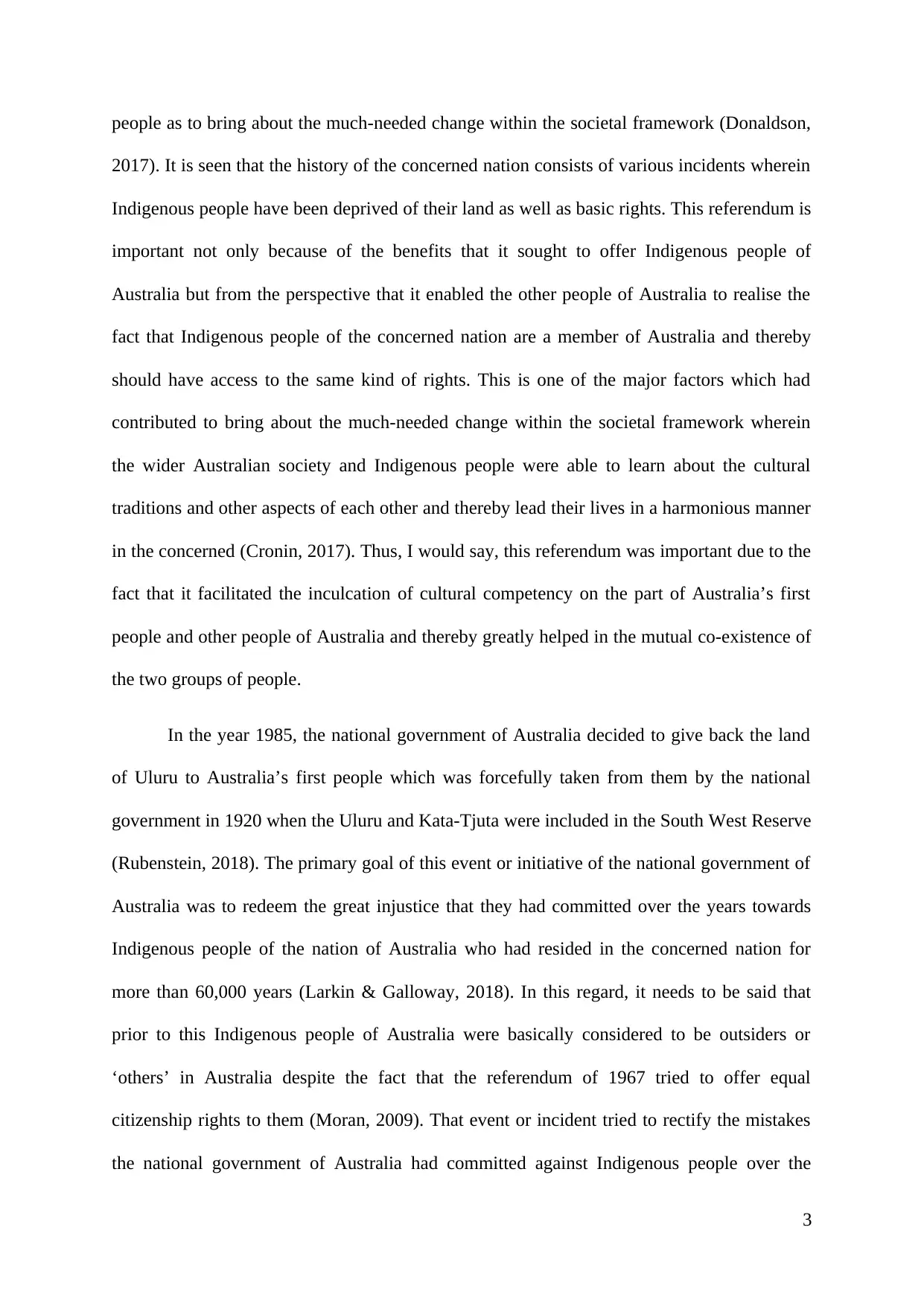
people as to bring about the much-needed change within the societal framework (Donaldson,
2017). It is seen that the history of the concerned nation consists of various incidents wherein
Indigenous people have been deprived of their land as well as basic rights. This referendum is
important not only because of the benefits that it sought to offer Indigenous people of
Australia but from the perspective that it enabled the other people of Australia to realise the
fact that Indigenous people of the concerned nation are a member of Australia and thereby
should have access to the same kind of rights. This is one of the major factors which had
contributed to bring about the much-needed change within the societal framework wherein
the wider Australian society and Indigenous people were able to learn about the cultural
traditions and other aspects of each other and thereby lead their lives in a harmonious manner
in the concerned (Cronin, 2017). Thus, I would say, this referendum was important due to the
fact that it facilitated the inculcation of cultural competency on the part of Australia’s first
people and other people of Australia and thereby greatly helped in the mutual co-existence of
the two groups of people.
In the year 1985, the national government of Australia decided to give back the land
of Uluru to Australia’s first people which was forcefully taken from them by the national
government in 1920 when the Uluru and Kata-Tjuta were included in the South West Reserve
(Rubenstein, 2018). The primary goal of this event or initiative of the national government of
Australia was to redeem the great injustice that they had committed over the years towards
Indigenous people of the nation of Australia who had resided in the concerned nation for
more than 60,000 years (Larkin & Galloway, 2018). In this regard, it needs to be said that
prior to this Indigenous people of Australia were basically considered to be outsiders or
‘others’ in Australia despite the fact that the referendum of 1967 tried to offer equal
citizenship rights to them (Moran, 2009). That event or incident tried to rectify the mistakes
the national government of Australia had committed against Indigenous people over the
3
2017). It is seen that the history of the concerned nation consists of various incidents wherein
Indigenous people have been deprived of their land as well as basic rights. This referendum is
important not only because of the benefits that it sought to offer Indigenous people of
Australia but from the perspective that it enabled the other people of Australia to realise the
fact that Indigenous people of the concerned nation are a member of Australia and thereby
should have access to the same kind of rights. This is one of the major factors which had
contributed to bring about the much-needed change within the societal framework wherein
the wider Australian society and Indigenous people were able to learn about the cultural
traditions and other aspects of each other and thereby lead their lives in a harmonious manner
in the concerned (Cronin, 2017). Thus, I would say, this referendum was important due to the
fact that it facilitated the inculcation of cultural competency on the part of Australia’s first
people and other people of Australia and thereby greatly helped in the mutual co-existence of
the two groups of people.
In the year 1985, the national government of Australia decided to give back the land
of Uluru to Australia’s first people which was forcefully taken from them by the national
government in 1920 when the Uluru and Kata-Tjuta were included in the South West Reserve
(Rubenstein, 2018). The primary goal of this event or initiative of the national government of
Australia was to redeem the great injustice that they had committed over the years towards
Indigenous people of the nation of Australia who had resided in the concerned nation for
more than 60,000 years (Larkin & Galloway, 2018). In this regard, it needs to be said that
prior to this Indigenous people of Australia were basically considered to be outsiders or
‘others’ in Australia despite the fact that the referendum of 1967 tried to offer equal
citizenship rights to them (Moran, 2009). That event or incident tried to rectify the mistakes
the national government of Australia had committed against Indigenous people over the
3
Secure Best Marks with AI Grader
Need help grading? Try our AI Grader for instant feedback on your assignments.
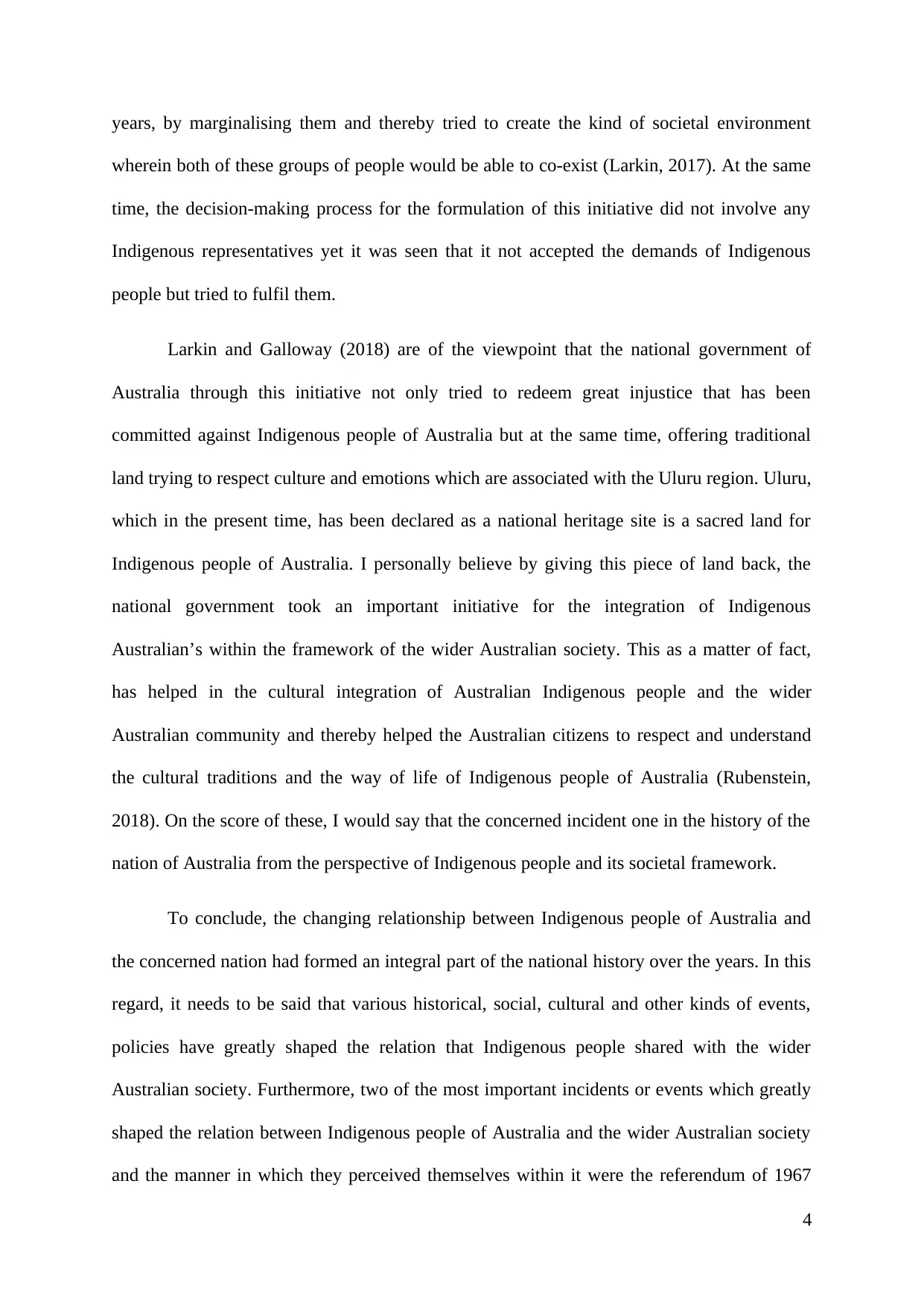
years, by marginalising them and thereby tried to create the kind of societal environment
wherein both of these groups of people would be able to co-exist (Larkin, 2017). At the same
time, the decision-making process for the formulation of this initiative did not involve any
Indigenous representatives yet it was seen that it not accepted the demands of Indigenous
people but tried to fulfil them.
Larkin and Galloway (2018) are of the viewpoint that the national government of
Australia through this initiative not only tried to redeem great injustice that has been
committed against Indigenous people of Australia but at the same time, offering traditional
land trying to respect culture and emotions which are associated with the Uluru region. Uluru,
which in the present time, has been declared as a national heritage site is a sacred land for
Indigenous people of Australia. I personally believe by giving this piece of land back, the
national government took an important initiative for the integration of Indigenous
Australian’s within the framework of the wider Australian society. This as a matter of fact,
has helped in the cultural integration of Australian Indigenous people and the wider
Australian community and thereby helped the Australian citizens to respect and understand
the cultural traditions and the way of life of Indigenous people of Australia (Rubenstein,
2018). On the score of these, I would say that the concerned incident one in the history of the
nation of Australia from the perspective of Indigenous people and its societal framework.
To conclude, the changing relationship between Indigenous people of Australia and
the concerned nation had formed an integral part of the national history over the years. In this
regard, it needs to be said that various historical, social, cultural and other kinds of events,
policies have greatly shaped the relation that Indigenous people shared with the wider
Australian society. Furthermore, two of the most important incidents or events which greatly
shaped the relation between Indigenous people of Australia and the wider Australian society
and the manner in which they perceived themselves within it were the referendum of 1967
4
wherein both of these groups of people would be able to co-exist (Larkin, 2017). At the same
time, the decision-making process for the formulation of this initiative did not involve any
Indigenous representatives yet it was seen that it not accepted the demands of Indigenous
people but tried to fulfil them.
Larkin and Galloway (2018) are of the viewpoint that the national government of
Australia through this initiative not only tried to redeem great injustice that has been
committed against Indigenous people of Australia but at the same time, offering traditional
land trying to respect culture and emotions which are associated with the Uluru region. Uluru,
which in the present time, has been declared as a national heritage site is a sacred land for
Indigenous people of Australia. I personally believe by giving this piece of land back, the
national government took an important initiative for the integration of Indigenous
Australian’s within the framework of the wider Australian society. This as a matter of fact,
has helped in the cultural integration of Australian Indigenous people and the wider
Australian community and thereby helped the Australian citizens to respect and understand
the cultural traditions and the way of life of Indigenous people of Australia (Rubenstein,
2018). On the score of these, I would say that the concerned incident one in the history of the
nation of Australia from the perspective of Indigenous people and its societal framework.
To conclude, the changing relationship between Indigenous people of Australia and
the concerned nation had formed an integral part of the national history over the years. In this
regard, it needs to be said that various historical, social, cultural and other kinds of events,
policies have greatly shaped the relation that Indigenous people shared with the wider
Australian society. Furthermore, two of the most important incidents or events which greatly
shaped the relation between Indigenous people of Australia and the wider Australian society
and the manner in which they perceived themselves within it were the referendum of 1967
4
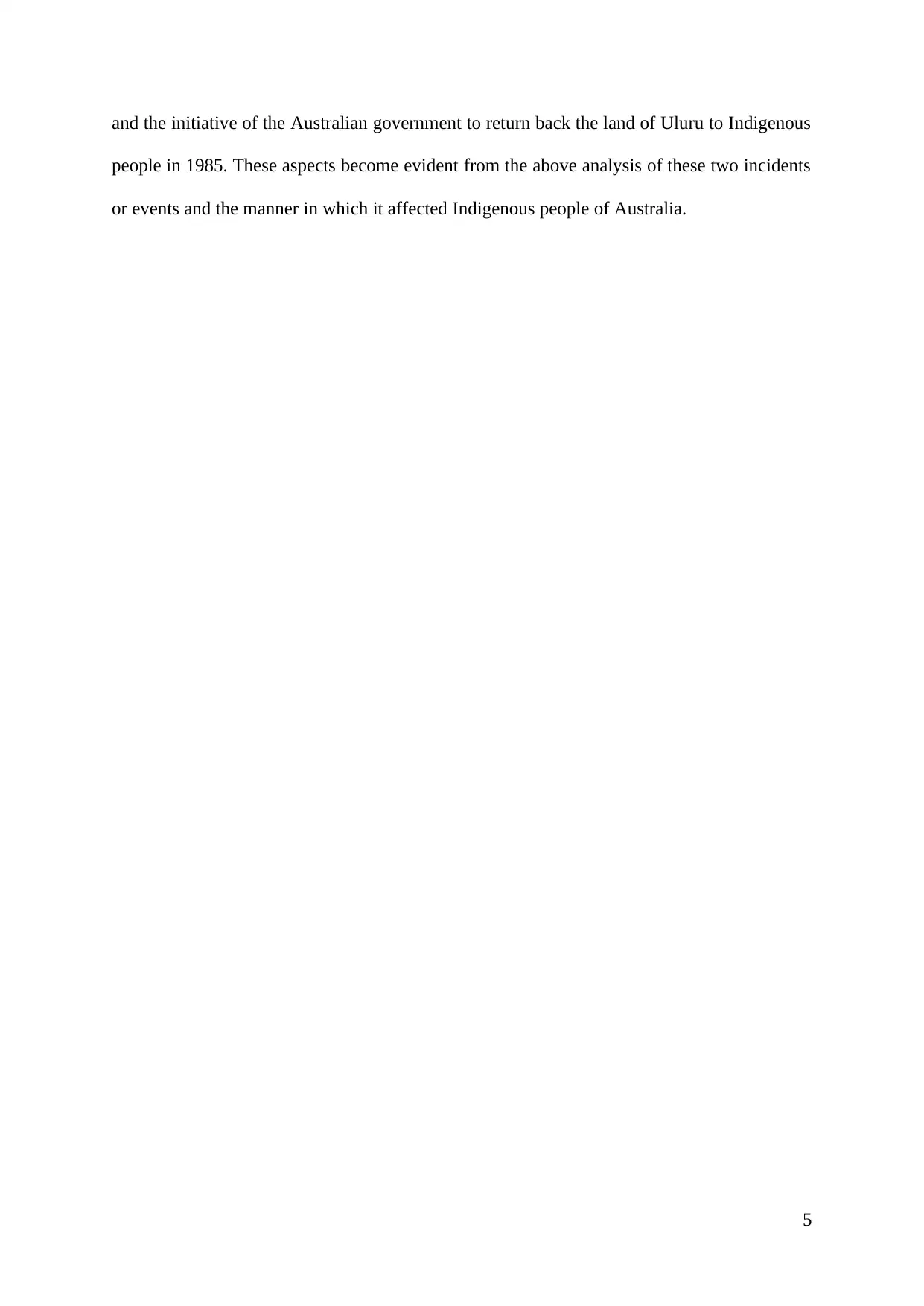
and the initiative of the Australian government to return back the land of Uluru to Indigenous
people in 1985. These aspects become evident from the above analysis of these two incidents
or events and the manner in which it affected Indigenous people of Australia.
5
people in 1985. These aspects become evident from the above analysis of these two incidents
or events and the manner in which it affected Indigenous people of Australia.
5
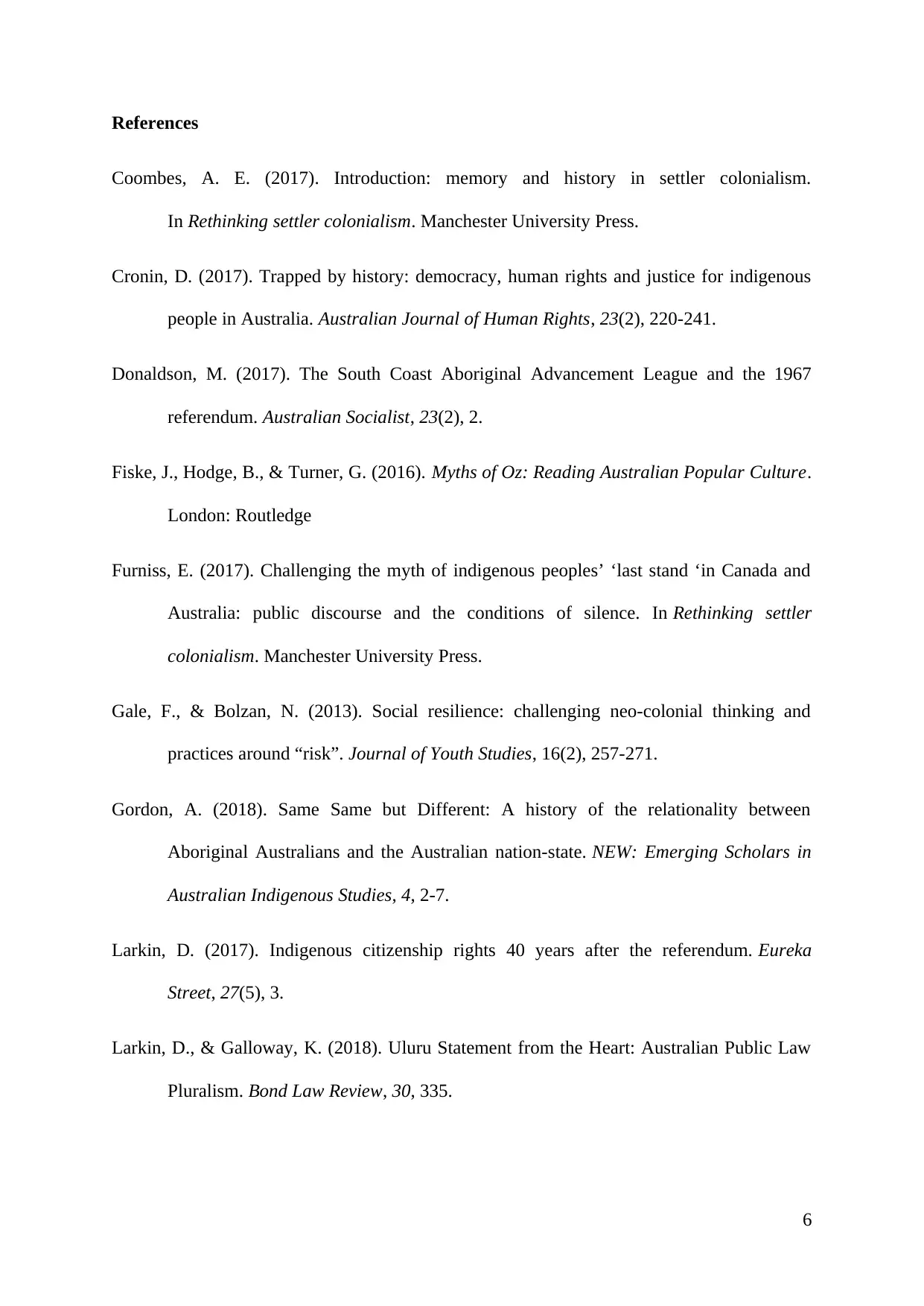
References
Coombes, A. E. (2017). Introduction: memory and history in settler colonialism.
In Rethinking settler colonialism. Manchester University Press.
Cronin, D. (2017). Trapped by history: democracy, human rights and justice for indigenous
people in Australia. Australian Journal of Human Rights, 23(2), 220-241.
Donaldson, M. (2017). The South Coast Aboriginal Advancement League and the 1967
referendum. Australian Socialist, 23(2), 2.
Fiske, J., Hodge, B., & Turner, G. (2016). Myths of Oz: Reading Australian Popular Culture.
London: Routledge
Furniss, E. (2017). Challenging the myth of indigenous peoples’ ‘last stand ‘in Canada and
Australia: public discourse and the conditions of silence. In Rethinking settler
colonialism. Manchester University Press.
Gale, F., & Bolzan, N. (2013). Social resilience: challenging neo-colonial thinking and
practices around “risk”. Journal of Youth Studies, 16(2), 257-271.
Gordon, A. (2018). Same Same but Different: A history of the relationality between
Aboriginal Australians and the Australian nation-state. NEW: Emerging Scholars in
Australian Indigenous Studies, 4, 2-7.
Larkin, D. (2017). Indigenous citizenship rights 40 years after the referendum. Eureka
Street, 27(5), 3.
Larkin, D., & Galloway, K. (2018). Uluru Statement from the Heart: Australian Public Law
Pluralism. Bond Law Review, 30, 335.
6
Coombes, A. E. (2017). Introduction: memory and history in settler colonialism.
In Rethinking settler colonialism. Manchester University Press.
Cronin, D. (2017). Trapped by history: democracy, human rights and justice for indigenous
people in Australia. Australian Journal of Human Rights, 23(2), 220-241.
Donaldson, M. (2017). The South Coast Aboriginal Advancement League and the 1967
referendum. Australian Socialist, 23(2), 2.
Fiske, J., Hodge, B., & Turner, G. (2016). Myths of Oz: Reading Australian Popular Culture.
London: Routledge
Furniss, E. (2017). Challenging the myth of indigenous peoples’ ‘last stand ‘in Canada and
Australia: public discourse and the conditions of silence. In Rethinking settler
colonialism. Manchester University Press.
Gale, F., & Bolzan, N. (2013). Social resilience: challenging neo-colonial thinking and
practices around “risk”. Journal of Youth Studies, 16(2), 257-271.
Gordon, A. (2018). Same Same but Different: A history of the relationality between
Aboriginal Australians and the Australian nation-state. NEW: Emerging Scholars in
Australian Indigenous Studies, 4, 2-7.
Larkin, D. (2017). Indigenous citizenship rights 40 years after the referendum. Eureka
Street, 27(5), 3.
Larkin, D., & Galloway, K. (2018). Uluru Statement from the Heart: Australian Public Law
Pluralism. Bond Law Review, 30, 335.
6
Paraphrase This Document
Need a fresh take? Get an instant paraphrase of this document with our AI Paraphraser

Macneil, R. (2017). Time after time: Temporal frontiers and boundaries in colonial images of
the Australian landscape. In Colonial frontiers. Manchester University Press.
Malaspinas, A. S., Westaway, M. C., Muller, C., Sousa, V. C., Lao, O., Alves, I., & Heupink,
T. H. (2016). A genomic history of Aboriginal Australia. Nature, 538(7624), 207.
McNiven, I. J. (2017). Torres Strait Islanders and the maritime frontier in early colonial
Australia. In Colonial frontiers. Manchester University Press.
Moran, A. (2009). What settler Australians talk about when they talk about Aborigines:
reflections on an in-depth interview study. Ethnic and Racial Studies, 32(5), 781-801.
Moran, A. (2011). Multiculturalism as nation-building in Australia: Inclusive national
identity and the embrace of diversity. Ethnic and Racial Studies, 34(12), 2153-2172.
Rubenstein, K. (2018). Power, Control and Citizenship: The Uluru Statement from the Heart
as Active Citizenship. Bond Law Review, 30, 19.
Waller, L., & McCallum, K. (2018). How television moved a nation: media, change and
Indigenous rights. Media, Culture & Society, 40(7), 992-1007.
7
the Australian landscape. In Colonial frontiers. Manchester University Press.
Malaspinas, A. S., Westaway, M. C., Muller, C., Sousa, V. C., Lao, O., Alves, I., & Heupink,
T. H. (2016). A genomic history of Aboriginal Australia. Nature, 538(7624), 207.
McNiven, I. J. (2017). Torres Strait Islanders and the maritime frontier in early colonial
Australia. In Colonial frontiers. Manchester University Press.
Moran, A. (2009). What settler Australians talk about when they talk about Aborigines:
reflections on an in-depth interview study. Ethnic and Racial Studies, 32(5), 781-801.
Moran, A. (2011). Multiculturalism as nation-building in Australia: Inclusive national
identity and the embrace of diversity. Ethnic and Racial Studies, 34(12), 2153-2172.
Rubenstein, K. (2018). Power, Control and Citizenship: The Uluru Statement from the Heart
as Active Citizenship. Bond Law Review, 30, 19.
Waller, L., & McCallum, K. (2018). How television moved a nation: media, change and
Indigenous rights. Media, Culture & Society, 40(7), 992-1007.
7
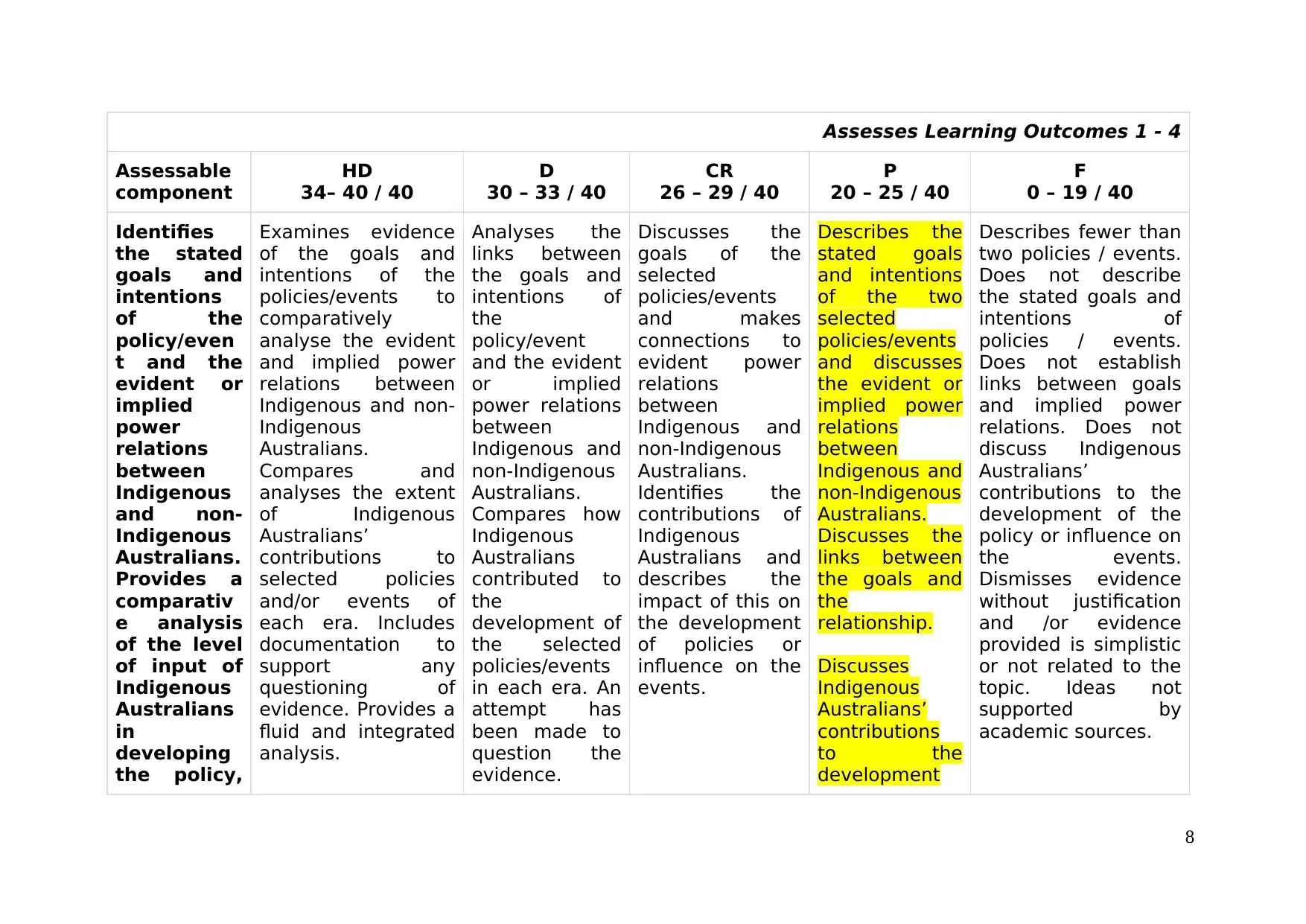
Assesses Learning Outcomes 1 - 4
Assessable
component
HD
34– 40 / 40
D
30 – 33 / 40
CR
26 – 29 / 40
P
20 – 25 / 40
F
0 – 19 / 40
Identifies
the stated
goals and
intentions
of the
policy/even
t and the
evident or
implied
power
relations
between
Indigenous
and non-
Indigenous
Australians.
Provides a
comparativ
e analysis
of the level
of input of
Indigenous
Australians
in
developing
the policy,
Examines evidence
of the goals and
intentions of the
policies/events to
comparatively
analyse the evident
and implied power
relations between
Indigenous and non-
Indigenous
Australians.
Compares and
analyses the extent
of Indigenous
Australians’
contributions to
selected policies
and/or events of
each era. Includes
documentation to
support any
questioning of
evidence. Provides a
fluid and integrated
analysis.
Analyses the
links between
the goals and
intentions of
the
policy/event
and the evident
or implied
power relations
between
Indigenous and
non-Indigenous
Australians.
Compares how
Indigenous
Australians
contributed to
the
development of
the selected
policies/events
in each era. An
attempt has
been made to
question the
evidence.
Discusses the
goals of the
selected
policies/events
and makes
connections to
evident power
relations
between
Indigenous and
non-Indigenous
Australians.
Identifies the
contributions of
Indigenous
Australians and
describes the
impact of this on
the development
of policies or
influence on the
events.
Describes the
stated goals
and intentions
of the two
selected
policies/events
and discusses
the evident or
implied power
relations
between
Indigenous and
non-Indigenous
Australians.
Discusses the
links between
the goals and
the
relationship.
Discusses
Indigenous
Australians’
contributions
to the
development
Describes fewer than
two policies / events.
Does not describe
the stated goals and
intentions of
policies / events.
Does not establish
links between goals
and implied power
relations. Does not
discuss Indigenous
Australians’
contributions to the
development of the
policy or influence on
the events.
Dismisses evidence
without justification
and /or evidence
provided is simplistic
or not related to the
topic. Ideas not
supported by
academic sources.
8
Assessable
component
HD
34– 40 / 40
D
30 – 33 / 40
CR
26 – 29 / 40
P
20 – 25 / 40
F
0 – 19 / 40
Identifies
the stated
goals and
intentions
of the
policy/even
t and the
evident or
implied
power
relations
between
Indigenous
and non-
Indigenous
Australians.
Provides a
comparativ
e analysis
of the level
of input of
Indigenous
Australians
in
developing
the policy,
Examines evidence
of the goals and
intentions of the
policies/events to
comparatively
analyse the evident
and implied power
relations between
Indigenous and non-
Indigenous
Australians.
Compares and
analyses the extent
of Indigenous
Australians’
contributions to
selected policies
and/or events of
each era. Includes
documentation to
support any
questioning of
evidence. Provides a
fluid and integrated
analysis.
Analyses the
links between
the goals and
intentions of
the
policy/event
and the evident
or implied
power relations
between
Indigenous and
non-Indigenous
Australians.
Compares how
Indigenous
Australians
contributed to
the
development of
the selected
policies/events
in each era. An
attempt has
been made to
question the
evidence.
Discusses the
goals of the
selected
policies/events
and makes
connections to
evident power
relations
between
Indigenous and
non-Indigenous
Australians.
Identifies the
contributions of
Indigenous
Australians and
describes the
impact of this on
the development
of policies or
influence on the
events.
Describes the
stated goals
and intentions
of the two
selected
policies/events
and discusses
the evident or
implied power
relations
between
Indigenous and
non-Indigenous
Australians.
Discusses the
links between
the goals and
the
relationship.
Discusses
Indigenous
Australians’
contributions
to the
development
Describes fewer than
two policies / events.
Does not describe
the stated goals and
intentions of
policies / events.
Does not establish
links between goals
and implied power
relations. Does not
discuss Indigenous
Australians’
contributions to the
development of the
policy or influence on
the events.
Dismisses evidence
without justification
and /or evidence
provided is simplistic
or not related to the
topic. Ideas not
supported by
academic sources.
8

or in
relation to
the event
pre-1967
and post-
1967.
10 marks
of the policy or
influence on
the events.
Ideas
supported by
academic
sources.
Demonstrat
es
understandi
ng of how
Indigenous
and non-
Indigenous
Australians
are
positioned
in the
policy/even
t pre-1967
and post-
1967.
10 marks
Analysis of the
positioning of
Indigenous and non-
Indigenous
Australians at a
collective and
individual level is
clear and
succinct. Examines
and compares this
positioning in each
era in which the
policy/event
occurred. Critically
analyses how
knowledge about
Australian history is
culturally and
institutionally
Compares and
analyses the
position of
Indigenous and
non-Indigenous
Australians at
an individual
and collective
level for both
policies/events.
Describes the
institutional
forces
impacting on
this positioning.
Analyses how
knowledge
about
Australian
Describes the
positioning of
Indigenous and
non-Indigenous
Australians at an
individual and
collective level
for both policies /
events.
Discusses how
knowledge about
Australian
history is socially
and culturally
reproduced to
reinforce
contemporary
understandings.
Describes the
positioning of
Indigenous and
non-Indigenous
Australians at
an individual
OR collective
level of two
policies /
events.
Discusses this
positioning in
each era in
which the
policy/event
occurred.
Broad outline
of how
No description of the
positioning of
Indigenous and non-
Indigenous
Australians at an
individual OR
collective level for
one or both
policies/events.
Analysis is grounded
in absolutes. There is
minimal
acknowledgement of
how knowledge
about Australian
history is socially
reproduced to
reinforce
contemporary
9
relation to
the event
pre-1967
and post-
1967.
10 marks
of the policy or
influence on
the events.
Ideas
supported by
academic
sources.
Demonstrat
es
understandi
ng of how
Indigenous
and non-
Indigenous
Australians
are
positioned
in the
policy/even
t pre-1967
and post-
1967.
10 marks
Analysis of the
positioning of
Indigenous and non-
Indigenous
Australians at a
collective and
individual level is
clear and
succinct. Examines
and compares this
positioning in each
era in which the
policy/event
occurred. Critically
analyses how
knowledge about
Australian history is
culturally and
institutionally
Compares and
analyses the
position of
Indigenous and
non-Indigenous
Australians at
an individual
and collective
level for both
policies/events.
Describes the
institutional
forces
impacting on
this positioning.
Analyses how
knowledge
about
Australian
Describes the
positioning of
Indigenous and
non-Indigenous
Australians at an
individual and
collective level
for both policies /
events.
Discusses how
knowledge about
Australian
history is socially
and culturally
reproduced to
reinforce
contemporary
understandings.
Describes the
positioning of
Indigenous and
non-Indigenous
Australians at
an individual
OR collective
level of two
policies /
events.
Discusses this
positioning in
each era in
which the
policy/event
occurred.
Broad outline
of how
No description of the
positioning of
Indigenous and non-
Indigenous
Australians at an
individual OR
collective level for
one or both
policies/events.
Analysis is grounded
in absolutes. There is
minimal
acknowledgement of
how knowledge
about Australian
history is socially
reproduced to
reinforce
contemporary
9
Secure Best Marks with AI Grader
Need help grading? Try our AI Grader for instant feedback on your assignments.
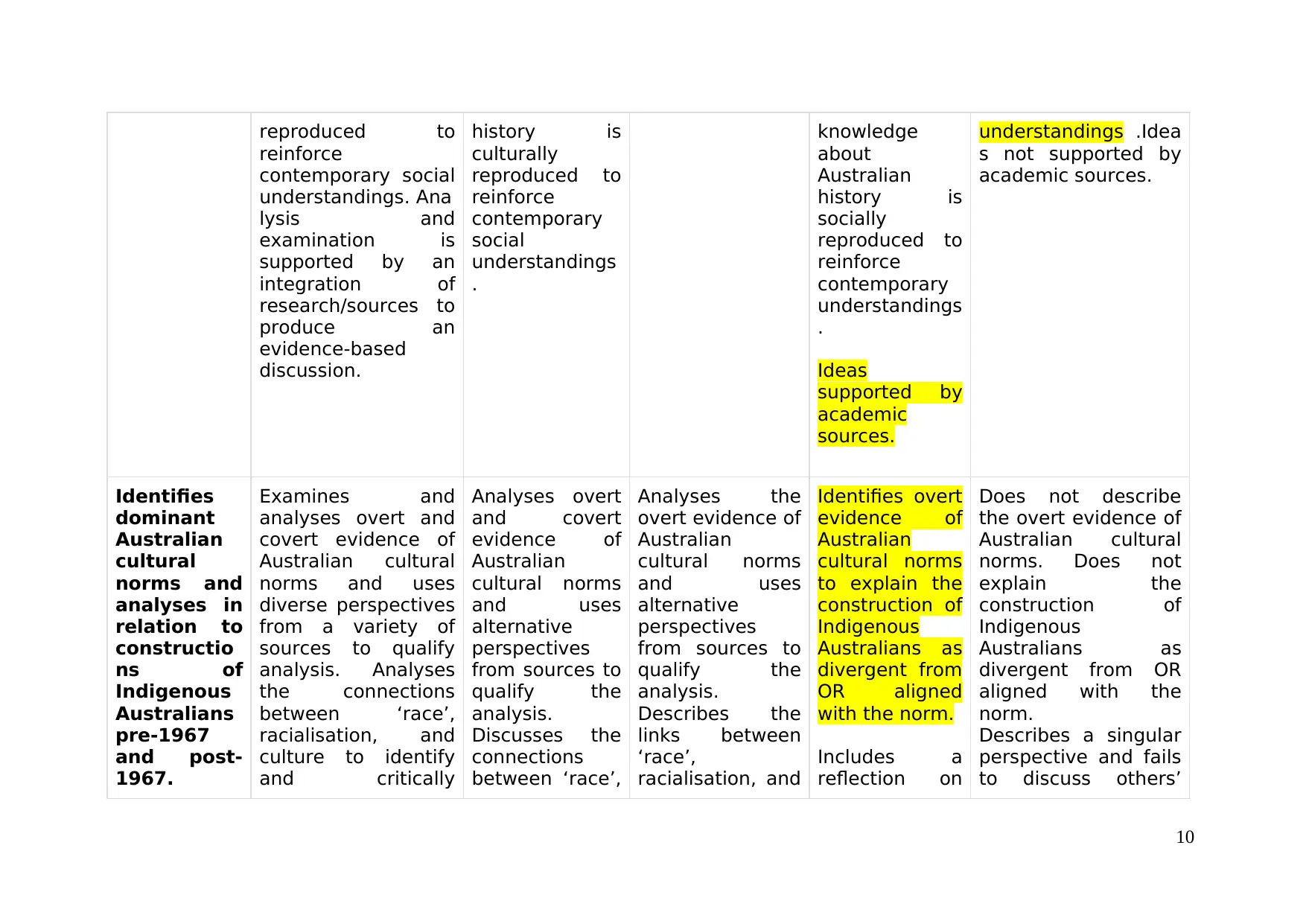
reproduced to
reinforce
contemporary social
understandings. Ana
lysis and
examination is
supported by an
integration of
research/sources to
produce an
evidence-based
discussion.
history is
culturally
reproduced to
reinforce
contemporary
social
understandings
.
knowledge
about
Australian
history is
socially
reproduced to
reinforce
contemporary
understandings
.
Ideas
supported by
academic
sources.
understandings .Idea
s not supported by
academic sources.
Identifies
dominant
Australian
cultural
norms and
analyses in
relation to
constructio
ns of
Indigenous
Australians
pre-1967
and post-
1967.
Examines and
analyses overt and
covert evidence of
Australian cultural
norms and uses
diverse perspectives
from a variety of
sources to qualify
analysis. Analyses
the connections
between ‘race’,
racialisation, and
culture to identify
and critically
Analyses overt
and covert
evidence of
Australian
cultural norms
and uses
alternative
perspectives
from sources to
qualify the
analysis.
Discusses the
connections
between ‘race’,
Analyses the
overt evidence of
Australian
cultural norms
and uses
alternative
perspectives
from sources to
qualify the
analysis.
Describes the
links between
‘race’,
racialisation, and
Identifies overt
evidence of
Australian
cultural norms
to explain the
construction of
Indigenous
Australians as
divergent from
OR aligned
with the norm.
Includes a
reflection on
Does not describe
the overt evidence of
Australian cultural
norms. Does not
explain the
construction of
Indigenous
Australians as
divergent from OR
aligned with the
norm.
Describes a singular
perspective and fails
to discuss others’
10
reinforce
contemporary social
understandings. Ana
lysis and
examination is
supported by an
integration of
research/sources to
produce an
evidence-based
discussion.
history is
culturally
reproduced to
reinforce
contemporary
social
understandings
.
knowledge
about
Australian
history is
socially
reproduced to
reinforce
contemporary
understandings
.
Ideas
supported by
academic
sources.
understandings .Idea
s not supported by
academic sources.
Identifies
dominant
Australian
cultural
norms and
analyses in
relation to
constructio
ns of
Indigenous
Australians
pre-1967
and post-
1967.
Examines and
analyses overt and
covert evidence of
Australian cultural
norms and uses
diverse perspectives
from a variety of
sources to qualify
analysis. Analyses
the connections
between ‘race’,
racialisation, and
culture to identify
and critically
Analyses overt
and covert
evidence of
Australian
cultural norms
and uses
alternative
perspectives
from sources to
qualify the
analysis.
Discusses the
connections
between ‘race’,
Analyses the
overt evidence of
Australian
cultural norms
and uses
alternative
perspectives
from sources to
qualify the
analysis.
Describes the
links between
‘race’,
racialisation, and
Identifies overt
evidence of
Australian
cultural norms
to explain the
construction of
Indigenous
Australians as
divergent from
OR aligned
with the norm.
Includes a
reflection on
Does not describe
the overt evidence of
Australian cultural
norms. Does not
explain the
construction of
Indigenous
Australians as
divergent from OR
aligned with the
norm.
Describes a singular
perspective and fails
to discuss others’
10
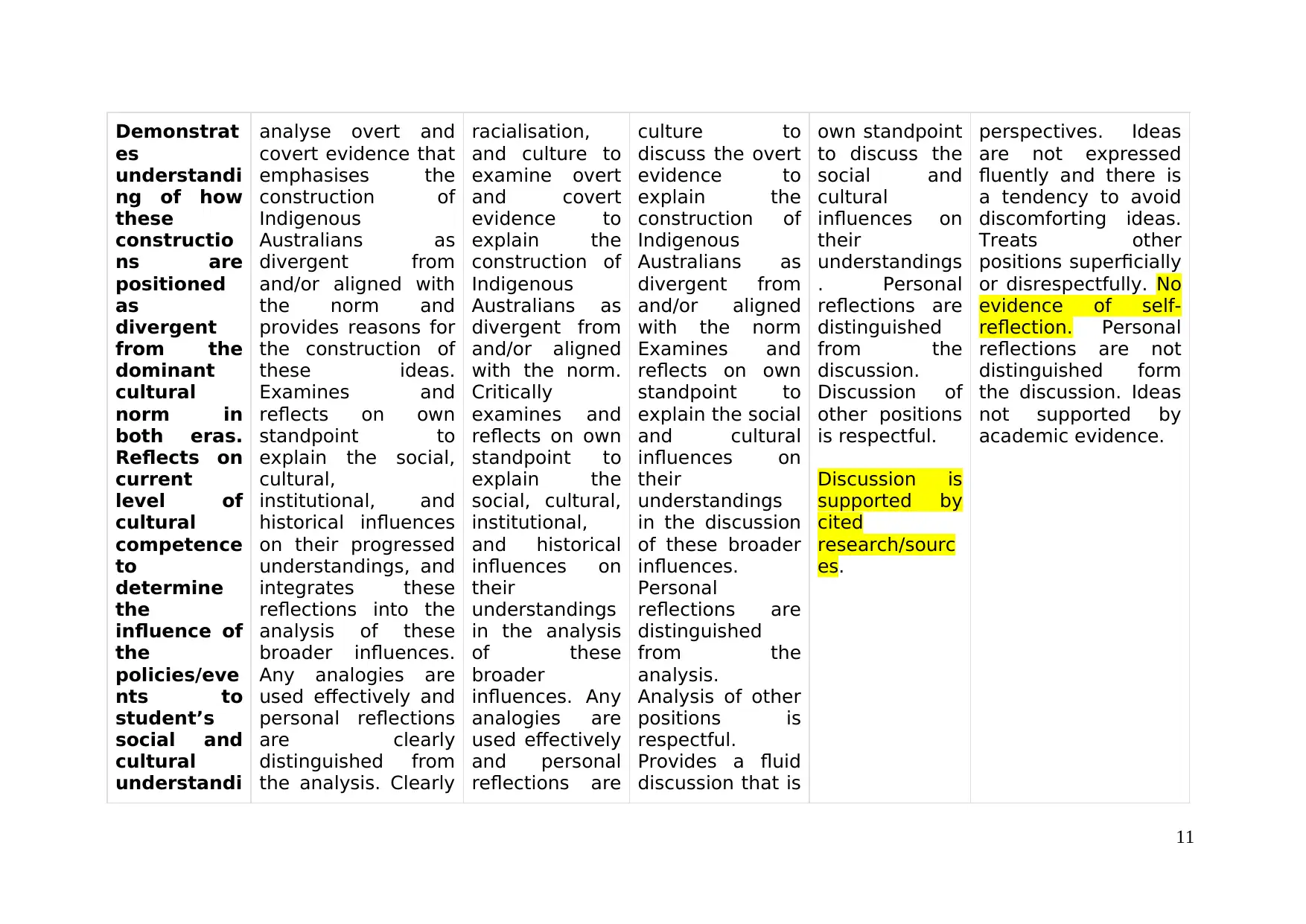
Demonstrat
es
understandi
ng of how
these
constructio
ns are
positioned
as
divergent
from the
dominant
cultural
norm in
both eras.
Reflects on
current
level of
cultural
competence
to
determine
the
influence of
the
policies/eve
nts to
student’s
social and
cultural
understandi
analyse overt and
covert evidence that
emphasises the
construction of
Indigenous
Australians as
divergent from
and/or aligned with
the norm and
provides reasons for
the construction of
these ideas.
Examines and
reflects on own
standpoint to
explain the social,
cultural,
institutional, and
historical influences
on their progressed
understandings, and
integrates these
reflections into the
analysis of these
broader influences.
Any analogies are
used effectively and
personal reflections
are clearly
distinguished from
the analysis. Clearly
racialisation,
and culture to
examine overt
and covert
evidence to
explain the
construction of
Indigenous
Australians as
divergent from
and/or aligned
with the norm.
Critically
examines and
reflects on own
standpoint to
explain the
social, cultural,
institutional,
and historical
influences on
their
understandings
in the analysis
of these
broader
influences. Any
analogies are
used effectively
and personal
reflections are
culture to
discuss the overt
evidence to
explain the
construction of
Indigenous
Australians as
divergent from
and/or aligned
with the norm
Examines and
reflects on own
standpoint to
explain the social
and cultural
influences on
their
understandings
in the discussion
of these broader
influences.
Personal
reflections are
distinguished
from the
analysis.
Analysis of other
positions is
respectful.
Provides a fluid
discussion that is
own standpoint
to discuss the
social and
cultural
influences on
their
understandings
. Personal
reflections are
distinguished
from the
discussion.
Discussion of
other positions
is respectful.
Discussion is
supported by
cited
research/sourc
es.
perspectives. Ideas
are not expressed
fluently and there is
a tendency to avoid
discomforting ideas.
Treats other
positions superficially
or disrespectfully. No
evidence of self-
reflection. Personal
reflections are not
distinguished form
the discussion. Ideas
not supported by
academic evidence.
11
es
understandi
ng of how
these
constructio
ns are
positioned
as
divergent
from the
dominant
cultural
norm in
both eras.
Reflects on
current
level of
cultural
competence
to
determine
the
influence of
the
policies/eve
nts to
student’s
social and
cultural
understandi
analyse overt and
covert evidence that
emphasises the
construction of
Indigenous
Australians as
divergent from
and/or aligned with
the norm and
provides reasons for
the construction of
these ideas.
Examines and
reflects on own
standpoint to
explain the social,
cultural,
institutional, and
historical influences
on their progressed
understandings, and
integrates these
reflections into the
analysis of these
broader influences.
Any analogies are
used effectively and
personal reflections
are clearly
distinguished from
the analysis. Clearly
racialisation,
and culture to
examine overt
and covert
evidence to
explain the
construction of
Indigenous
Australians as
divergent from
and/or aligned
with the norm.
Critically
examines and
reflects on own
standpoint to
explain the
social, cultural,
institutional,
and historical
influences on
their
understandings
in the analysis
of these
broader
influences. Any
analogies are
used effectively
and personal
reflections are
culture to
discuss the overt
evidence to
explain the
construction of
Indigenous
Australians as
divergent from
and/or aligned
with the norm
Examines and
reflects on own
standpoint to
explain the social
and cultural
influences on
their
understandings
in the discussion
of these broader
influences.
Personal
reflections are
distinguished
from the
analysis.
Analysis of other
positions is
respectful.
Provides a fluid
discussion that is
own standpoint
to discuss the
social and
cultural
influences on
their
understandings
. Personal
reflections are
distinguished
from the
discussion.
Discussion of
other positions
is respectful.
Discussion is
supported by
cited
research/sourc
es.
perspectives. Ideas
are not expressed
fluently and there is
a tendency to avoid
discomforting ideas.
Treats other
positions superficially
or disrespectfully. No
evidence of self-
reflection. Personal
reflections are not
distinguished form
the discussion. Ideas
not supported by
academic evidence.
11
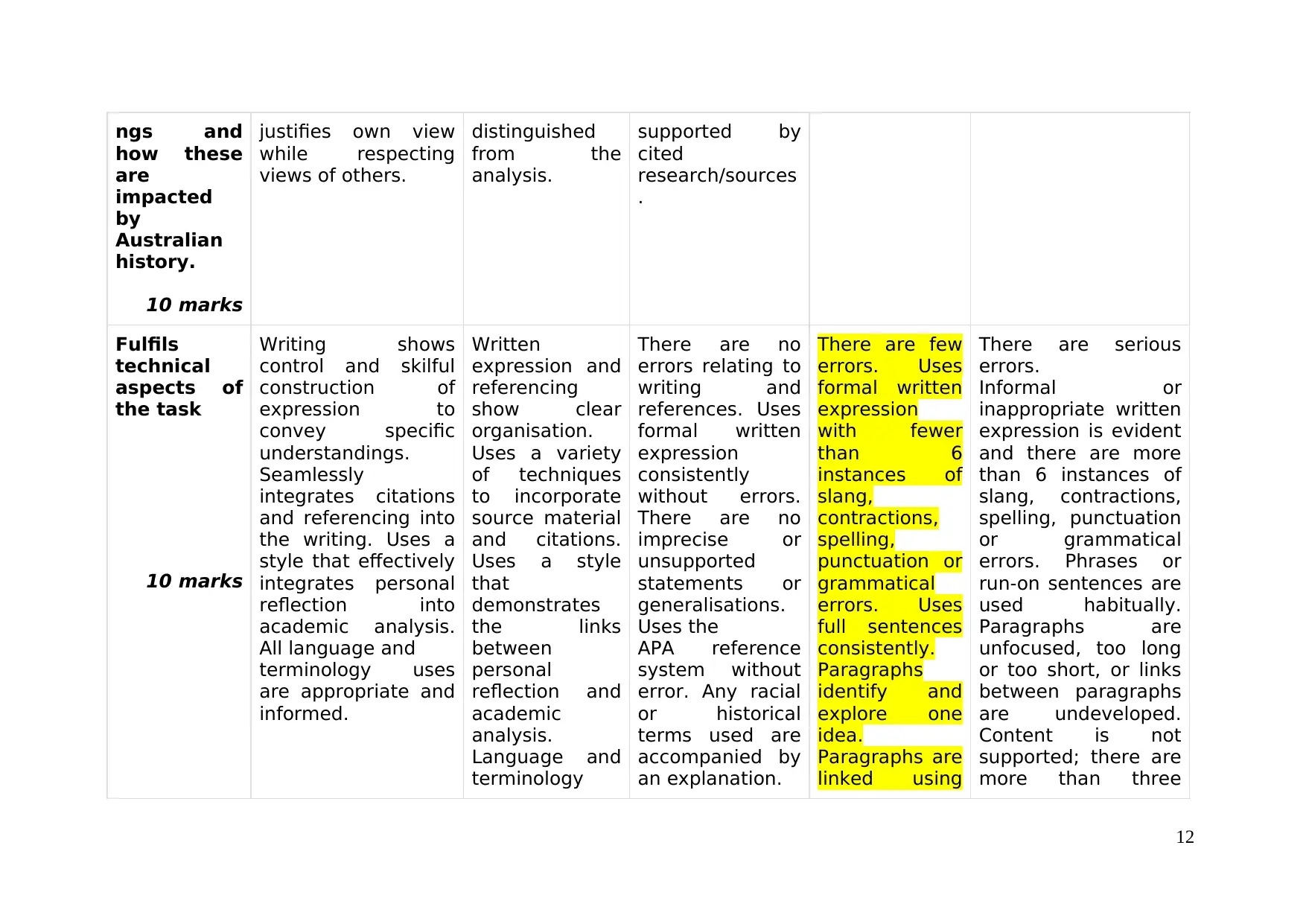
ngs and
how these
are
impacted
by
Australian
history.
10 marks
justifies own view
while respecting
views of others.
distinguished
from the
analysis.
supported by
cited
research/sources
.
Fulfils
technical
aspects of
the task
10 marks
Writing shows
control and skilful
construction of
expression to
convey specific
understandings.
Seamlessly
integrates citations
and referencing into
the writing. Uses a
style that effectively
integrates personal
reflection into
academic analysis.
All language and
terminology uses
are appropriate and
informed.
Written
expression and
referencing
show clear
organisation.
Uses a variety
of techniques
to incorporate
source material
and citations.
Uses a style
that
demonstrates
the links
between
personal
reflection and
academic
analysis.
Language and
terminology
There are no
errors relating to
writing and
references. Uses
formal written
expression
consistently
without errors.
There are no
imprecise or
unsupported
statements or
generalisations.
Uses the
APA reference
system without
error. Any racial
or historical
terms used are
accompanied by
an explanation.
There are few
errors. Uses
formal written
expression
with fewer
than 6
instances of
slang,
contractions,
spelling,
punctuation or
grammatical
errors. Uses
full sentences
consistently.
Paragraphs
identify and
explore one
idea.
Paragraphs are
linked using
There are serious
errors.
Informal or
inappropriate written
expression is evident
and there are more
than 6 instances of
slang, contractions,
spelling, punctuation
or grammatical
errors. Phrases or
run-on sentences are
used habitually.
Paragraphs are
unfocused, too long
or too short, or links
between paragraphs
are undeveloped.
Content is not
supported; there are
more than three
12
how these
are
impacted
by
Australian
history.
10 marks
justifies own view
while respecting
views of others.
distinguished
from the
analysis.
supported by
cited
research/sources
.
Fulfils
technical
aspects of
the task
10 marks
Writing shows
control and skilful
construction of
expression to
convey specific
understandings.
Seamlessly
integrates citations
and referencing into
the writing. Uses a
style that effectively
integrates personal
reflection into
academic analysis.
All language and
terminology uses
are appropriate and
informed.
Written
expression and
referencing
show clear
organisation.
Uses a variety
of techniques
to incorporate
source material
and citations.
Uses a style
that
demonstrates
the links
between
personal
reflection and
academic
analysis.
Language and
terminology
There are no
errors relating to
writing and
references. Uses
formal written
expression
consistently
without errors.
There are no
imprecise or
unsupported
statements or
generalisations.
Uses the
APA reference
system without
error. Any racial
or historical
terms used are
accompanied by
an explanation.
There are few
errors. Uses
formal written
expression
with fewer
than 6
instances of
slang,
contractions,
spelling,
punctuation or
grammatical
errors. Uses
full sentences
consistently.
Paragraphs
identify and
explore one
idea.
Paragraphs are
linked using
There are serious
errors.
Informal or
inappropriate written
expression is evident
and there are more
than 6 instances of
slang, contractions,
spelling, punctuation
or grammatical
errors. Phrases or
run-on sentences are
used habitually.
Paragraphs are
unfocused, too long
or too short, or links
between paragraphs
are undeveloped.
Content is not
supported; there are
more than three
12
Paraphrase This Document
Need a fresh take? Get an instant paraphrase of this document with our AI Paraphraser
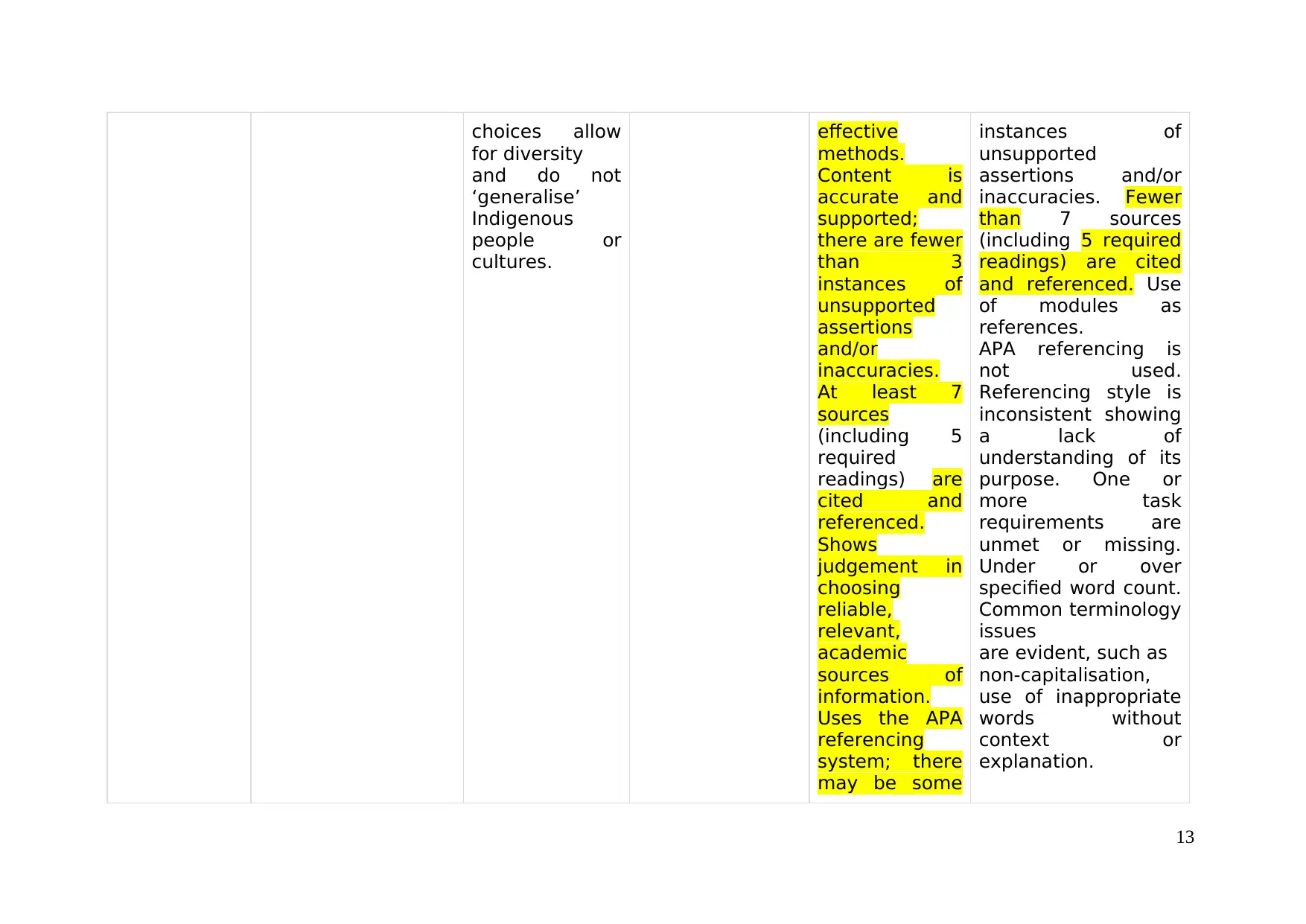
choices allow
for diversity
and do not
‘generalise’
Indigenous
people or
cultures.
effective
methods.
Content is
accurate and
supported;
there are fewer
than 3
instances of
unsupported
assertions
and/or
inaccuracies.
At least 7
sources
(including 5
required
readings) are
cited and
referenced.
Shows
judgement in
choosing
reliable,
relevant,
academic
sources of
information.
Uses the APA
referencing
system; there
may be some
instances of
unsupported
assertions and/or
inaccuracies. Fewer
than 7 sources
(including 5 required
readings) are cited
and referenced. Use
of modules as
references.
APA referencing is
not used.
Referencing style is
inconsistent showing
a lack of
understanding of its
purpose. One or
more task
requirements are
unmet or missing.
Under or over
specified word count.
Common terminology
issues
are evident, such as
non-capitalisation,
use of inappropriate
words without
context or
explanation.
13
for diversity
and do not
‘generalise’
Indigenous
people or
cultures.
effective
methods.
Content is
accurate and
supported;
there are fewer
than 3
instances of
unsupported
assertions
and/or
inaccuracies.
At least 7
sources
(including 5
required
readings) are
cited and
referenced.
Shows
judgement in
choosing
reliable,
relevant,
academic
sources of
information.
Uses the APA
referencing
system; there
may be some
instances of
unsupported
assertions and/or
inaccuracies. Fewer
than 7 sources
(including 5 required
readings) are cited
and referenced. Use
of modules as
references.
APA referencing is
not used.
Referencing style is
inconsistent showing
a lack of
understanding of its
purpose. One or
more task
requirements are
unmet or missing.
Under or over
specified word count.
Common terminology
issues
are evident, such as
non-capitalisation,
use of inappropriate
words without
context or
explanation.
13

errors however
there is
consistency in
approach. All
task
requirements
have been met
and submitted.
Within
specified word
count.
Use of
appropriate
terminology is
developing.
Achievements: Thank you for your essay, Kelly. You have chosen two relevant events to discuss and analyse and have provided a sound
overview of how Indigenous people were positioned in these events. You have also identified the contribution (or lack of contribution) of
Indigenous people in the events.
Things to improve: You are missing a couple of elements, so make sure you use your rubric to help guide you through the task. For example,
you needed to explain how knowledge about Australian history is socially reproduced to reinforce contemporary
understandings and you also needed to include a reflection on your own standpoint to discuss the social and
cultural influences on your understandings. You would have been better able to develop these ideas in the
necessary depth had you engaged with the required readings in the subject. I also encourage you to keep
working on developing your points as clearly and concisely as possible.
14
there is
consistency in
approach. All
task
requirements
have been met
and submitted.
Within
specified word
count.
Use of
appropriate
terminology is
developing.
Achievements: Thank you for your essay, Kelly. You have chosen two relevant events to discuss and analyse and have provided a sound
overview of how Indigenous people were positioned in these events. You have also identified the contribution (or lack of contribution) of
Indigenous people in the events.
Things to improve: You are missing a couple of elements, so make sure you use your rubric to help guide you through the task. For example,
you needed to explain how knowledge about Australian history is socially reproduced to reinforce contemporary
understandings and you also needed to include a reflection on your own standpoint to discuss the social and
cultural influences on your understandings. You would have been better able to develop these ideas in the
necessary depth had you engaged with the required readings in the subject. I also encourage you to keep
working on developing your points as clearly and concisely as possible.
14
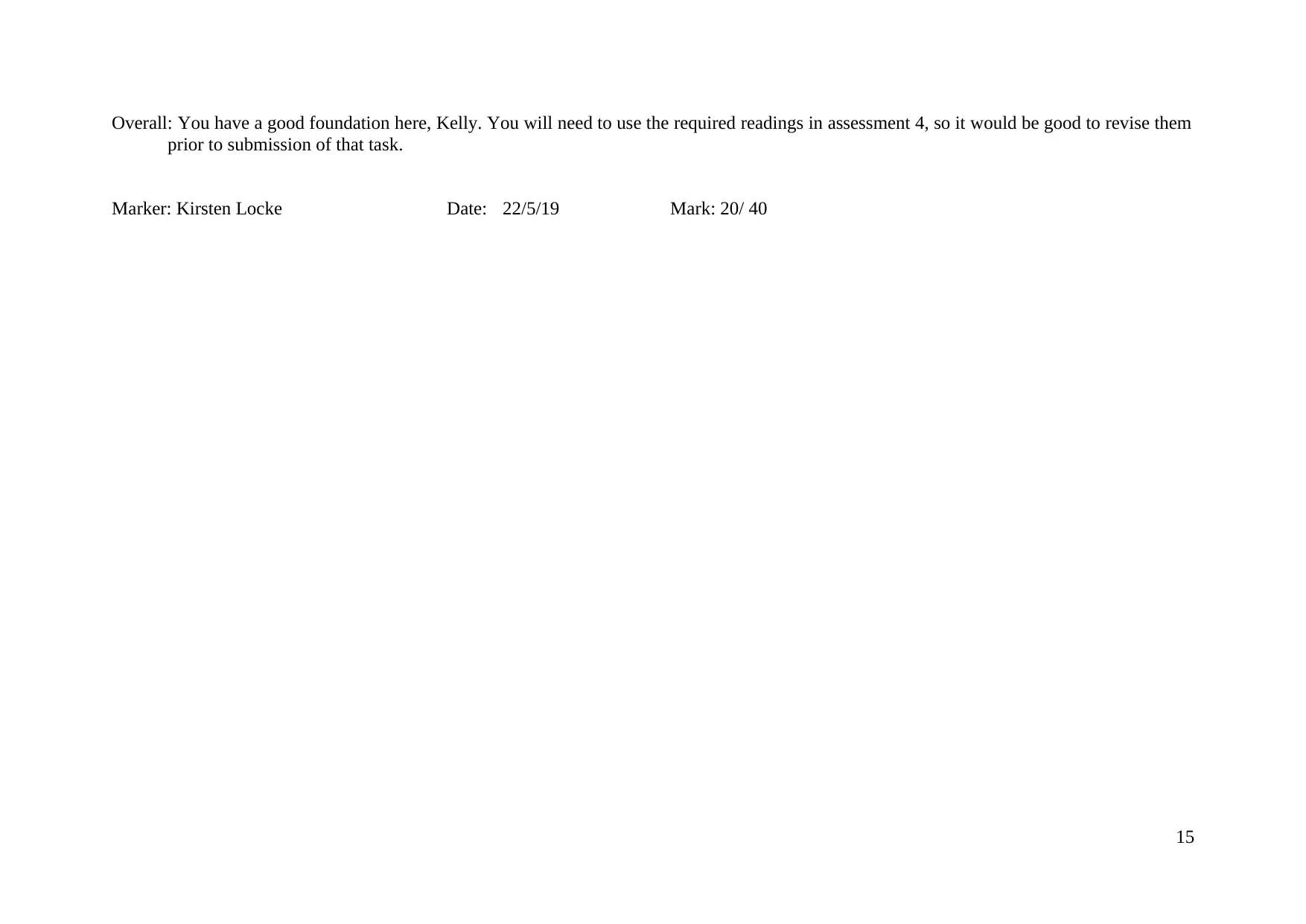
Overall: You have a good foundation here, Kelly. You will need to use the required readings in assessment 4, so it would be good to revise them
prior to submission of that task.
Marker: Kirsten Locke Date: 22/5/19 Mark: 20/ 40
15
prior to submission of that task.
Marker: Kirsten Locke Date: 22/5/19 Mark: 20/ 40
15
1 out of 16
Related Documents
Your All-in-One AI-Powered Toolkit for Academic Success.
+13062052269
info@desklib.com
Available 24*7 on WhatsApp / Email
![[object Object]](/_next/static/media/star-bottom.7253800d.svg)
Unlock your academic potential
© 2024 | Zucol Services PVT LTD | All rights reserved.





